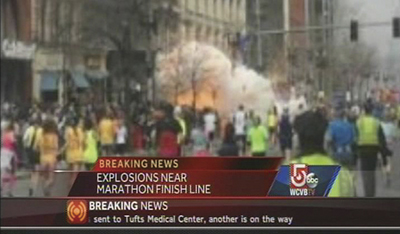A Viewer’s Point of View
BOSTON—In the aftermath of the Boston Marathon bombing on April 15, user-generated video would come to tell a big part of the story, as eyewitnesses uploaded photos and footage shot on cellphones, smartphones and other mobile devices to social media, YouTube and local news stations.
Local ABC affiliate WCVB Channel 5 began to see a steady uptick in user submissions, some on the 15th but increasingly more over the next few days. “As people began to look at what they had shot, they began to realize they had pictures germane to the bombing,” said Neil Ungerleider, WCVB manager of digital. “In one case a user had a photo of Dzhokhar Tsarnaev fleeing the scene, but didn’t realize what it was until a few days later. After the suspects were identified, that picture became very meaningful.”

Keith Wymbs, vice president of marketing for Elemental Technologies But for the Hearst Television-owned station, the most telling videos would come in on Friday, April 19, from the residents of Watertown, Mass., where the manhunt for the two suspects culminated in a community lock-down and a firefight. The station received about a dozen videos shot by residents trapped inside their homes while law enforcement and the suspects traded fire outside. With no media access to the scene— “correctly so,” Ungerleider noted—and the fluid nature of the story, those videos shot by citizens through their windows provided the best vantage point as events unfolded.
“You heard the gunfire and the explosions,” Ungerleider said of the videos. “The experience was something none of us had ever seen, and we realized what we were doing was important work that needed to be done very well and we needed to apply all of our journalistic standards to doing it.”
FADE INTO THE BACKGROUND
From a newsroom perspective, the technology platform that enabled WCVB to go live with broadcast-quality versions of those videos was among the unsung heroes in the story. In the midst of preparing viewer- submitted content for air, the myriad technical challenges of transcoding video must fade into the background as the focus becomes vetting the material’s relevance, newsworthiness and authenticity in near-real time.
“The station was able to tell the story through many different eyes very quickly through user-generated video,” said Joe Addalia, director of technology, Hearst Television Inc. “From a technologist’s point of view, I found it incredibly interesting as a prime example of how the traditional means of gathering news is really no longer traditional—it’s all untraditional.”
Large station groups like Hearst and other news organizations have embraced user-generated video—and citizen journalism on a broader level—as an essential reporting tool. They’re providing viewers with online submission platforms and tying those systems seamlessly into newsroom production for output on-air and/or online.
The professional video industry's #1 source for news, trends and product and tech information. Sign up below.
Hearst, for example, developed “u local” about five years ago, Addalia said, to enable its 29 stations nationwide to collect user-generated videos and photos. U local is featured on each station’s website and integrated into locally branded apps. At the local level, usage typically spikes during major weather events, when citizen reporting can bring remote stories to life.
Similarly, CNN’s iReport platform, created by Turner Broadcasting’s BEST (Broadcasting Engineering and Systems Technology) group, is now in its second generation. Available on CNN websites internationally and distributed via a number of CNN apps, it sees about 500 user submissions a day worldwide.

For WCVB Channel 5 in Boston, user-generated video played an important role in the station’s coverage of the Boston Marathon bombing in April. NBC News’ acquisition of user-generated video service Stringwire in August signals it is also looking closely at how to integrate citizen journalism more tightly into its news ecosphere. Stringwire’s technology enables the collection of live video from around the world from a verified network of contributors via Twitter, making it ideal “for breaking news and stories that have a real-time visual component,” NBC News said in its announcement. (Beyond that initial announcement, NBC News has been mum on its plans and declined to comment for this article.)
INCREASING CHOICES
While user-generated video has become a standard component of news coverage, the technological challenges of transcoding and managing it for broadcast playout are only increasing as the plethora of devices, operating systems, and formats available to consumers multiplies. Each of those factors complicates the process of converting the video from the vast array of mobile video formats to broadcast-quality.
Once the video is transcoded and distributed to the newsroom, metadata is essential to vetting and managing it. Best collected at the time the video is uploaded, metadata is what enabled WCVB, for instance, to get those sensitive Watertown videos on-air as the dire situation was unfolding.
Systems are typically best-of-breed solutions, combining software developed inhouse with off-the-shelf products to provide newsrooms a soup-to-nuts system for transcoding and moving the video. Leading vendors of transcoding products include Telestream, Elemental Technologies, Harmonic, Matrox, Snell and Digital Rapids, among others.
Turner built CNN’s iReport from scratch because at the time (2006), it was the only option, but in general the company develops most of its systems in-house. “If we were doing it all again from scratch today, there are lots of vendors out there,” said Chris Hinton, Turner Broadcasting vice president of software development. “But with our scale, our size, most vendors can’t deal with the complexity and breadth of our organization.”
The operational burden of managing user-submitted content is often overlooked, Hinton said. While most U.S. adults have smartphones, most are not professional shooters. Informing citizen journalists about what is and isn’t usable can go a long way toward easing that burden.
“People don’t know how to shoot video; they jiggle the camera, they move it around, so you can have unstable video that’s not great on-air when it’s blown up,” Hinton explained. “We spend time getting users to understand how to shoot video and images, and not to shoot in portrait mode.”
Efforts like those are important as the definition of what constitutes “user-generated” video is evolving as quickly as the enabling technology. The once clearly identifiable line between professional and user-generated content is much less distinct.
“It used to be really clear back 10 years ago: What people created for their own purposes vs. what was shot by a professional; one for capturing a moment, and one for distribution,” said Keith Wymbs, vice president of marketing, Elemental Technologies in Portland, Ore. “But with the advent of citizen journalists, the lines are blurring… and there’s been a push to encourage prosumers, to helping those individuals have a means of distributing their content and constantly educating that base.”
CONTENT IS STILL KING
But the bottom line when it comes to getting user-generated video on-air is the value of the content itself. “If it’s a great video, [the producer] will run through fire to get it on-air, and it has little to do with what technology is available,” said John Pallett, director of product management, enterprise products, at Telestream in Nevada City, Calif. “They will use whatever they have to get it on-air if it’s really good stuff.”
WCVB’s Ungurleider noted that television viewers have a higher tolerance for video quality in breaking-news situations. In the case of the Watertown coverage, he said, user-generated video “was the only visual account of what was going on, and the video being unsteady or out of focus was not a consideration when putting it on TV.”
“Citizen journalism is an unstoppable freight train,” Turner’s Hinton said. “It is going to get huge, and organizations that don’t embrace it and are not actively engaged in it will get left behind.”
